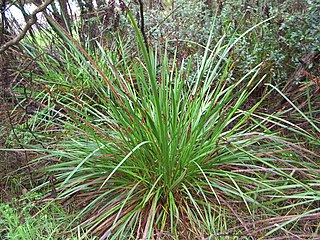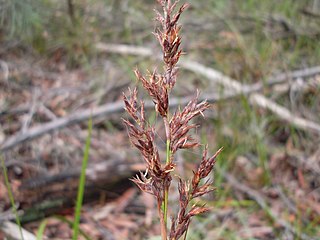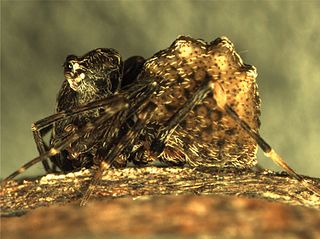
Lepidosperma gladiatum is commonly known as the coast sword-sedge or coastal sword-sedge. It is an evergreen species of sedge that is native to southern coastal areas of Australia. It was described by French botanist Jacques Labillardière in 1805. The Noongar name for the plant is kerbein.

Lepidosperma effusum, commonly known as the riverside sword sedge or spreading sword sedge, is an evergreen species of sedge that is native to southwest Western Australia.

Lepidosperma is a genus of flowering plant of the family Cyperaceae. Most of the species are endemic to Australia, with others native to southern China, southeast Asia, New Guinea, New Caledonia and New Zealand.

Lepidosperma longitudinale is commonly known as the pithy sword-sedge or pith saw-sedge. It is an evergreen species of sedge that is native to swampy areas of most Australian states. It was described by French botanist Jacques Labillardière in 1805.

Lepidosperma urophorum, the rapier saw sedge is a forest dwelling plant found in south eastern Australia. Often found on sandy soils near streams. It may grow to 1.5 metres high.

Lepidosperma laterale, commonly known as the variable swordsedge, is a plant found in south-eastern Australia, New Caledonia and New Zealand. It is often found on sandy soils or rocky areas in wooded areas.

Lepidosperma concavum, commonly known as the sandhill sword-sedge, is a plant found in coastal regions of south-eastern and eastern Australia. It grows on sandy soils in woodland, forest and heathland.

Lepidosperma filiforme, also known as the common rapier-sedge, is a sedge that occurs in coastal regions of south-eastern Australia and New Zealand. Plants grow to between 0.3 and 1 metre high. The culms are smooth, rigid, terete and between 0.7 and 2 mm in diameter. The leaves are also terete and about 1

Lepidosperma elatius is a species of plant from sedge family that can be found in Australia. The plant grows to a height of 1–2.5 metres, with leaves and which are convex on both sides, with sharp margins. The spikelets have a drooping spray with a length of 18–65 centimetres (7.1–25.6 in). The plant flowers from November to April.

Lepidosperma chinense, also known as the Chinese scaleseed sedge, is a plant widely distributed across Fujian, Guangdong, Guangxi, Hainan, Hunan, Zhejiang, Indonesia, Malaysia, Papua New Guinea, and Vietnam.

Machaerina juncea, commonly known as bare twig-rush or tussock swamp twig rush, is a sedge in the sedge family, Cyperaceae, that is native to Australia, New Zealand, and New Caledonia.

Lepidosperma angustatum is a sedge of the family Cyperaceae that is native to Western Australia.

Zephyrarchaea mainae is a species of spider, informally known as Main's assassin spider, Albany assassin spider, and the Western archaeid spider. The first of the assassin spider family found in Western Australia, the species was unknown until its collection at Torndirrup National Park near Albany was published in 1987.

Lepidosperma tetraquetrum is a sedge of the family Cyperaceae that is native to Southwest Australia.

Lepidosperma squamatum is a species of flowering plant in the sedge family, Cyperaceae. It is native to Southwest Australia. It was described by Jacques Labillardière in Novae Hollandiae Plantarum Specimen (1805). The specific epithet squamatum is derived from the Latin for 'scale', in reference to the form of the bracts.

Lepidosperma leptostachyum is a species of flowering plant in the sedge family, Cyperaceae, a native of Southwest Australia.

Lepidosperma viscidum, the sticky saw sedge, is a grass like plant found in south eastern Australia. Usually seen in heath and woodland on sandy and rocky sites, it may grow to 60 centimetres high. This is one of the many plants first published by Robert Brown with the type known as "(M.) v.v." appearing in his Prodromus Florae Novae Hollandiae et Insulae Van Diemen in 1810. The specific epithet viscidum is derived from the Latin with a meaning of "sticky", which refers to the sticky resin from the base and margins of the leaves and stem margins. On drying, the resin turns a red colour.

Lepidosperma canescens is a sedge of the family Cyperaceae that is native to south-east South Australia and Victoria. There are no synonyms.

Lepidosperma amantiferrum is a sedge of the family Cyperaceae that is endemic to Western Australia. It has no synonyms.

Lepidosperma asperatum is a sedge that is endemic to Western Australia. It was first described in 1941 by Georg Kükenthal as Lepidosperma leptostachyum var. asperatum, but was elevated to species status in 2012 by Karen Wilson and Russell Barrett.


















